Volume 26, No. 1, Spring 1996
- Vol. 19, No. 1, 1989
- Vol. 21 (Fall 1991), No. 2
- Vol. 21 (Spring 1991), No. 1
- Vol. 22 (Fall 1992) No. 2
- Vol. 22 (Spring 1992), No. 1
- Vol. 23 (Fall 1993), No. 2
- Vol. 23 (Spring 1993), No. 1
- Vol. 24, No. 1, Fall 1994
- Vol. 24, No. 2, Fall 1994
- Vol. 29, No. 1, Spring 1999
- Vol. 29, No. 2, Fall 1999
- Vol. 30, No. 1, Spring 2000
- Vol. 30, No. 2, Fall 2000
- Vol. 31, No. 1, Spring 2001
- Vol. 31, No. 2, Fall 2001
- Vol. 32, No. 1, Spring 2002
- Vol. 32, No. 2, Fall 2002
- Vol. 33, 2003
- Vol. 34, 2004
- Vol. 35, 2005
- Vol. 36, 2006
- Vol. 37, 2007
- Vol. 38, 2008
- Vol. 39, 2009
- Vol. 40, 2010
- Volume 19, No. 2, Fall 1989
- Volume 20 (Fall 1990), No. 2
- Volume 20 (Spring 1990), No. 1
- Volume 25, No. 1, Spring 1995
- Volume 25, No. 2, Fall 1995
- Volume 26, No. 1, Spring 1996
- Volume 26, No. 2, Fall 1996
- Volume 27, No. 1, Spring 1997
- Volume 27, No. 2, Fall 1997
- Volume 28, No. 1, Spring 1998
- Volume 28, No. 2, Fall 1998
- Indices

MILITARY HISTORY OF THE WEST-TOC - 1996
Volume 26, No. 1, Spring 1996
Table of Contents
"Pancho Villa Rides into Mexican Legend; Or, The Cavalry Myth and Military Tactics in the Mexican Revolution," by Jeffrey M. Pilcher, pp. 1-22.
Abstract: Cavalry of the Mexican Revolution of 1910 actually fought as mounted infantry. This
challenges the standard interpretation that Francisco "Pancho" Villa lost the decisive
battle of Celaya because his Division of the North charged vainly on horseback against
the machine guns of Alvaro Obregon's modern army.
Key Words: Mexican Revolution; Francisco "Pancho" Villa; Alvaro Obregon; cavalry tactics
"A Time for Desperate Valor: The Confederate Attack on Fort Butler, Louisiana, 1863," by James T. Matthews, pp. 23-34.
Abstract: Near the end of June 1863, Confederate forces under Major General Richard Taylor attempted to divert Union troops from the siege of Vicksburg by launching an offensive in southern Louisiana. As part of the Confederate effort, General Thomas Green's Texas cavalry attacked Fort Butler, a Union earthwork near Donaldsonville, on the night of 27 June. In a desperate assault that proved ill-advised, Green's force lost nearly half their number and failed to capture the fort.
Key Words: Civil War; Fort Butler; Confederate cavalry; Thomas Green; James Major
"Dogs of Destiny, Hounds from Hell: American Soldiers and Canines in the Mexican War," by Douglas A. Murphy, pp. 35-48.
Abstract: Unheralded, uncounted, and often unnoticed, man's best friend joined United States
soldiers in the Mexican War. Descriptions of these dogs, their wartime roles, and
their behavior reveal the depths of the soldier's belief in a "Yankee" destiny. Discussions
of Mexican dogs provide similar insights into preconceptions and prejudices that soldiers
directed toward their foes.
Key Words: Mexican War; dogs; U.S. soldiers; Manifest Destiny
"The Catalonian Volunteers on the Northwest Coast, 1790-1793: An Example of the Spanish Defensive System in North America," by Lance R. Blyth, pp. 49-65.
Abstract: Relatively little is known about the Spanish defensive system in eighteenth-century
North America -- especially the Spanish defensive expansion up the western coast of
North America, culminating in the occupation of Nootka Sound on Vancouver Island.
The actions and activities of the garrison force at Nootka, the Catalonian Volunteers,
are illustrative of the Spanish system. A limited strategy led to limited operations
with limited tactics. This aspect of Spain's military system has often been overlooked
or misunderstood.
Key Words: New Spain; Spanish Navy; Catalonian Volunteers; Nootka Sound; Vancouver Island